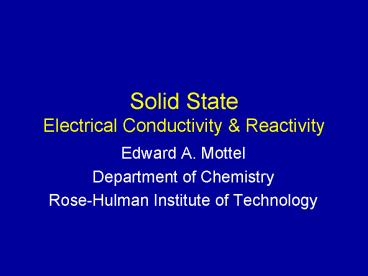Solid State Electrical Conductivity - PowerPoint PPT Presentation
1 / 29
Title:
Solid State Electrical Conductivity
Description:
Diode. a combination of an. n-type semiconductor. and a ... Light Emitting Diodes. E. h. c. h = 6.62 x 10-34 J s molecule-1. c = 3.00 x 108 m s-1. band gap ... – PowerPoint PPT presentation
Number of Views:349
Avg rating:3.0/5.0
Title: Solid State Electrical Conductivity
1
Solid StateElectrical Conductivity Reactivity
- Edward A. Mottel
- Department of Chemistry
- Rose-Hulman Institute of Technology
2
Solid State Electrical Conductivity
- Solid ionic compounds are poor electrical
conductors. - Mobile charges (ions or electrons) are needed for
electrical conductivity. - The difference in energy of bonding and
antibonding orbitals in a solid can explain many
electrical properties.
3
BondingBand Theory
4
BondingBand Theory
for silicon the valence band is full the
conduction band is empty
5
Band Gap
carbon (diamond)
silicon
germanium
tin
Smaller gap for heavier elements
6
Band Gap
graphite has a different structure than
diamond and is a conductor
diamond - insulator
semimetal, semiconductor
grey tin - metallic, conductor
Smaller gap for heavier elements
7
BondingCovalent and Metallic Bonding
conduction band
Insulator
Metallic Conductor
8
Density of States
overlapping mos in extended structure
levels are not uniformly spaced
Insulator
Metal
Semiconductor
9
Conductivity
10
Band Gap
free electrons or holes move charge
higher temperature puts more e- in conduction band
11
Conductivity
12
Elements in Semiconductors
N
O
B
C
F
P
S
Al
Si
Cl
As
Se
Ga
Ge
Zn
Cu
Br
Sb
Te
In
Sn
Cd
Ag
I
Intrinsic Si, Ge, Fe3O4
Alloys GaP, GaAs, ZnS, CdS, CdSe, SiC
13
Doped Semiconductors
conduction band
valence band
14
Diode
n-type
p-type
a combination of an n-type semiconductor and
a p-type semiconductor that allows current
flow in a preferred direction
15
Diode
n-type
p-type
e- flow can occur with e- moving to more
stable energy levels
Both conduct because there are mobile electrons
or holes and locations to move to.
Battery provides e- on one side and drain on
the other side.
e-
e-
-
16
Diode
n-type
p-type
Current flow in the reverse direction requires e-
move to higher energy levels, and occurs only
with large applied potentials (breakdown voltage).
The semiconductors are charge neutral, and
additional charge will build up in the valence
band preventing significant current flow.
e-
e-
17
Diode
Current ?
? Reverse Bias
Forward Bias ?
Applied Voltage
18
Light Emitting Diodes
band gap
wavelength (color)
h 6.62 x 10-34 Jsmolecule-1
c 3.00 x 108 ms-1
19
(No Transcript)
20
Solid State Photoreactions
Ag
Ag
Ag
Br-
Br-
Br-
Ag
Ag
Ag
Br-
Br-
Br-
Ag
Ag
Ag
Br-
Br-
Br-
Ag
Ag
Ag
Br-
Br-
Br-
Ag
Ag
Ag
Br-
Br-
Br-
Ag
Ag
Ag
Br-
Br-
Br-
21
Solid State Photoreactions
Ag
Ag
Ag
Br-
Br-
Br-
Ag
Ag
Ag
Br-
Br-
Br-
Ag
Ag
Ag
Br-
Br
Br-
Ag
Ag
Ag
Br-
Br-
Br-
Ag
Ag
Ag
Br-
Br-
Br-
Ag
Ag
Ag
Br-
Br-
Br-
22
AgBr(s) ? Ag(s) ½ Br2(l)
½ Br2(g)
325 kJmol-1
Ag(g)
Br-(g)
Ag(g)
Ag(l)
Ag(s) Br2(l)
100 kJmol-1
AgBr(s)
major energy requirement is reverse of EA of Br-
23
AgBr(s) ? Ag(s) ½ Br2(l)
E 325,000 Jmol-1
h 6.62 x 10-34 Jsmolecule-1
c 3.00 x 108 ms-1
mol 6.02 x 1023 molecules
(near uv)
24
1-2-3 SuperconductorYBa2Cu3O7
25
Resistivity
metal
superconductor
Tc
26
Superconductivity
27
(No Transcript)
28
Heavier Members of a Familytend to form single
bonds
29
(No Transcript)































